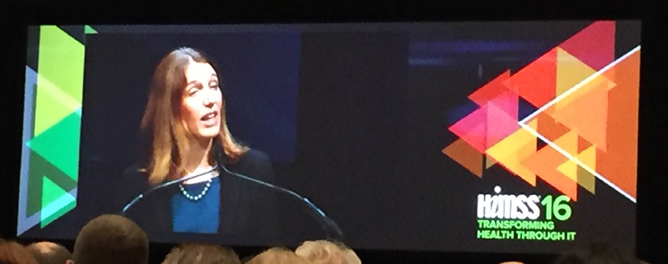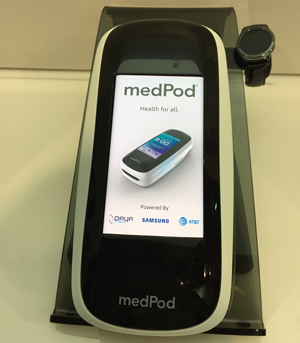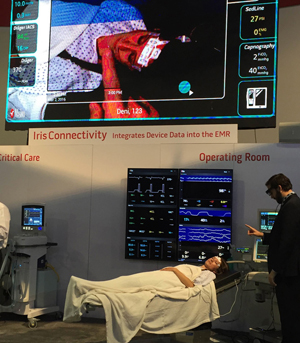
HIMSS16: Population health, data security, and an increased focus on interoperability are posed to transform health IT
HIMSS16: Population health, data security, and an increased focus on interoperability are posed to transform health IT
by Cynthia Weber
From 29 February – 4 March, nearly 42,000 people gathered in Las Vegas, NV, for the annual conference of the Healthcare Information and Management Systems Society—HIMSS16. This year’s conference and exhibition showed double-digit growth in attendance, which correlates with the ever-increasing influence of technology and informatics on health care. Popular discussion topics and information sessions focused on population health, cybersecurity, wearables and the Internet of things (IoT), and interoperability.
HIMSS16 opened Monday evening with keynote speakers Sylvia Mathews Burwell, Secretary of Health and Human Services, and Michael Dell, Chairman and CEO, Dell Inc., and HIMSS16 Chair, Dana Alexander, welcomed attendees. In her address, Alexander highlighted the challenges of transforming health through information technology and discussed key national quality in health care objectives, emphasizing the need for preventative care—keeping people healthy and out of the hospital. This objective is particularly important when considering an aging U.S. population, as well as the fact that 1% of the U.S. population accounts for 23% of healthcare spending, while 5% of the population accounts for 50% of healthcare dollars. Alexander challenged the audience to further consider ways to improve overall health outcomes while spending less per capita, noting that one successful tactic that has been increasingly employed is data mining—essentially using regional demographic information to identify those people who need health care, often at-risk patients, before chronic illness takes hold.
Sylvia Mathews Burwell (Figure 1) echoed this emphasis on the potential uses of data mining for community health by highlighting the situation in Flint, Michigan, and commended Dr. Mona Hanna-Attisha, the pediatrician who exposed the spread of lead poisoning following the change in the city’s water supply by searching and collecting evidence from city-wide health data.

Figure 1: Sylvia Mathews Burwell, Secretary of Health and Human Services, speaking at HIMSS16.
In addition to the topic of population health, Burwell outlined the current three-part strategy of the Department of Health and Human Services (HHS) in regards to health care: paying for quality of care versus quantity of care; prioritizing wellness and prevention; and unlocking data information across providers. “Without agreement on a common data alphabet,” she said, “our efforts are stopped.” Therefore, she continued, we must demand interoperability, and to effectively communicate, “we need to speak the same language.” Burwell also emphasized the importance of keeping data private and secure, and noted that recent cyber threats within healthcare systems were being taken seriously by the HHS’s Health Care Industry Cybersecurity Task Force.
In his session, Michael Dell (Figure 2) also discussed the role of real time data in population health and reiterated the need for security of healthcare data. He noted that the going rate for an electronic medical record (EMR) on the black market is now US$363, and throughout the healthcare system there is the strong “potential for manipulation of data.” To combat these threats, Dell Inc. is investing US$150 billion in microsegmentation to help secure health information.

Figure 2: Michael Dell, CEO of Dell Inc., at HIMSS16.
Wearables and the Internet of Things (IoT) featured prominently throughout the exhibition showroom as well as in a number of daily presentations. Companies such as Samsung featured next generation devices that monitored and dispensed daily medication intake (Figure 3), for example, and Vivify Health introduced their latest suite of home and mobile technologies for patient monitoring—the first end-to-end digital platform using consumer electronics that is integrated with EMRs. Masimo showcased new smart glasses under clinical trial—a partnership with Atheer Air—for use by anesthesiologists in the emergency room (Figure 4).


Figure 3, left: The Samsung medPod® is a cellular portable medication dispenser that connects to the cloud.
Figure 4, right: Demonstration of Atheer Air smart glasses, which allow the user to access patient data and vital statistics at the bedside, at the Masimo booth during HIMSS16.
The Intelligent Hospital Pavilion once again hosted Wearables Wednesday, where David Metcalf, Ph. D., noted that currently there are more than 300 companies in the wearables market, a number that is likely to grow steadily in the coming years with the continued interest in the “quantified self” and population health. Now, the market is moving to further engage consumers with devices for the home environment, particularly geared toward the elderly population, as well as more sophisticated and better connected on-the-go wearables for digital health monitoring. This growth further underscores the need for increased security and privacy control for devices as well as standards that serve to optimize data sharing across networks and multiple healthcare providers. As one presenter noted, the “blockbuster drug” of the twenty-first century is going to be patient engagement, and wearables and in-home monitoring devices, along with standards and interoperability protocols, are posed to make this possible.
Standards and interoperability were definitely buzz words throughout the conference, with major announcements by Secretary Burwell regarding interoperability commitments on behalf of the five largest healthcare systems, and the Office of the National Coordinator for Health Information Technology (ONC) call for input on measuring interoperability progress. Culturally, the healthcare industry is transitioning from closed loop to open systems, setting the stage for the next wave of healthcare IT innovation based on Open application programming interfaces (API). This move is posed to further change the way health care is perceived and delivered, offering a more “patient-centered” approach to wellness and health.
Cynthia Weber, Ph.D., is associate editor of the IEEE Life Sciences Newsletter.






